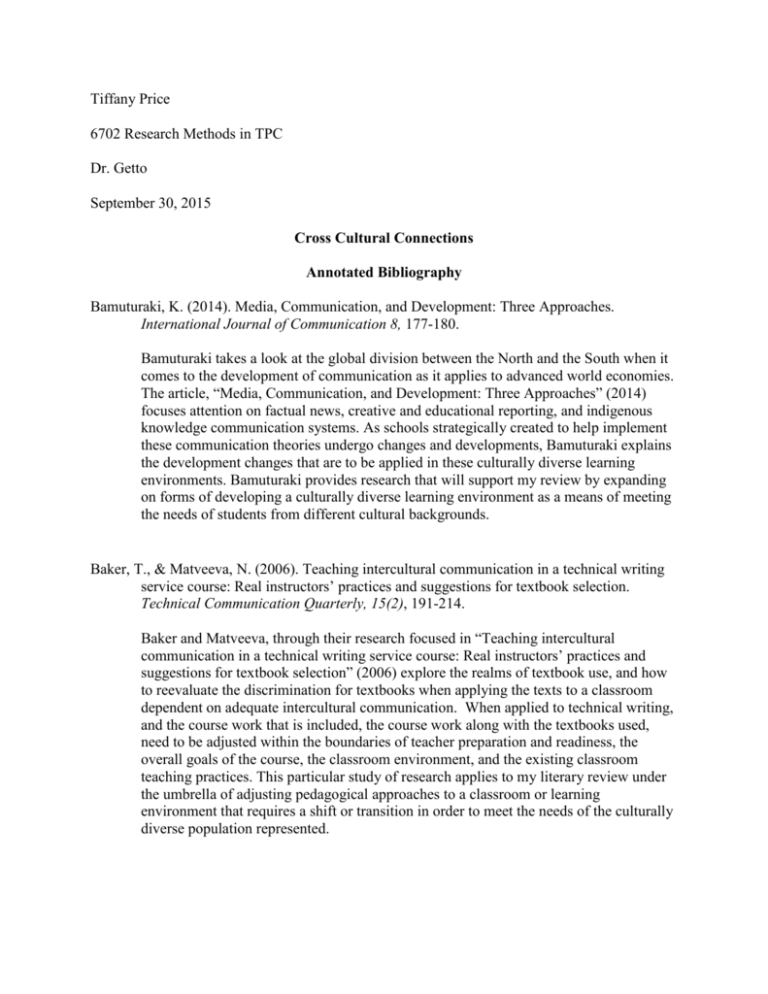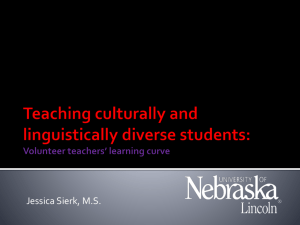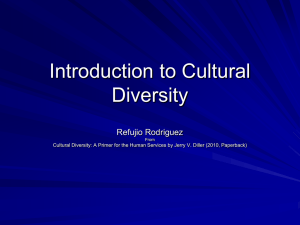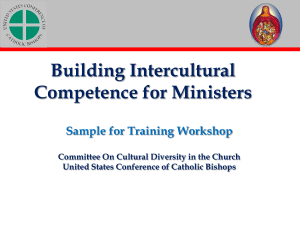priceannotatedbibmodule2
advertisement

Tiffany Price 6702 Research Methods in TPC Dr. Getto September 30, 2015 Cross Cultural Connections Annotated Bibliography Bamuturaki, K. (2014). Media, Communication, and Development: Three Approaches. International Journal of Communication 8, 177-180. Bamuturaki takes a look at the global division between the North and the South when it comes to the development of communication as it applies to advanced world economies. The article, “Media, Communication, and Development: Three Approaches” (2014) focuses attention on factual news, creative and educational reporting, and indigenous knowledge communication systems. As schools strategically created to help implement these communication theories undergo changes and developments, Bamuturaki explains the development changes that are to be applied in these culturally diverse learning environments. Bamuturaki provides research that will support my review by expanding on forms of developing a culturally diverse learning environment as a means of meeting the needs of students from different cultural backgrounds. Baker, T., & Matveeva, N. (2006). Teaching intercultural communication in a technical writing service course: Real instructors’ practices and suggestions for textbook selection. Technical Communication Quarterly, 15(2), 191-214. Baker and Matveeva, through their research focused in “Teaching intercultural communication in a technical writing service course: Real instructors’ practices and suggestions for textbook selection” (2006) explore the realms of textbook use, and how to reevaluate the discrimination for textbooks when applying the texts to a classroom dependent on adequate intercultural communication. When applied to technical writing, and the course work that is included, the course work along with the textbooks used, need to be adjusted within the boundaries of teacher preparation and readiness, the overall goals of the course, the classroom environment, and the existing classroom teaching practices. This particular study of research applies to my literary review under the umbrella of adjusting pedagogical approaches to a classroom or learning environment that requires a shift or transition in order to meet the needs of the culturally diverse population represented. Chambers, M. (2014). The Development, Design, and Pedagogical Implications for Blackboard. Critical Examination of Distance Education Transformation across the Disciplines, 196210. Chambers dedicates her research to whiteness, based on authorship as well as ownership of blackboard and how this realm has created a hegemonic dynamic within online learning. The designers of blackboard were white males, and they marketed blackboard to universities with a high racially white presence among the student body. Thus, the initial design of blackboard creates a barrier for minority learners, or learners from a culturally diverse background, because the material is presented in a text based format. This chapter confirms the growing racial diversity of an online classroom, and therefore aligns with my research in regard to the need for online instructors to use a multi-modal approach in order to engage minority students in the learning process. Day, C.R., & Frye, C.M. (2011). Global training, multicultural course design, and delivery: The impact on cultural style adjustments of faculty and global training instructors. Rhetoric, Professional Communication and Globalization 2 (1), 34-50. Day and Frye look to expand research in the area of culturally diverse learning environments and work places through their research conducted in “Global training, multicultural course design, and delivery: The impact on cultural style adjustments of faculty and global training instructors” (2011). As a result of such a culturally diverse learning environment, Day and Frye strive to provide suggestions for adjusted teacher training and pedagogies. As the American work world expands to include multicultural backgrounds of multiple nations, it poses the question for advanced training to prepare for work and learning environments composed of a culturally diverse people group. This research will connect to my studies through the advancement on teacher training to help instructors reach across cultural barriers in an effort to support a culturally diverse learning environment. Duin, A.H., & Moses, J. (2015). Intercultural connectivism: Introducing personal learning networks. Rhetoric, Professional Communication and Globalization 7 (1), 29-46. Duin and Moses (2015) base their research in the development of Personal Learning Networks (PLN) as a means of expanding education into culturally diverse areas. Through their research in “Intercultural connectivism: Introducing personal learning networks,” they conduct research that is specific to how students are capable of learning if they are from a culturally diverse background. Through the dedication of researching new technological advancements to meet the needs of students who are to be encouraged to reach across cultural boundaries in a learning environment, Duin and Moses were able to prove that intercultural competence increased with the implications of PLNs. This research is applicable to my studies as I dissect the ever changing pedagogical approaches taken by instructors in a diverse learning environment. Gates, K. (2013). Key Questions for Communication and Critical-Cultural Studies: Posthumanism, Network Infrastructures, and Sustainability. Communication & Critical/Cultural Studies 10 (2/3), 242-247. Gates writes about some of the questions that are posed by lack of research in the areas of posthumanism, network infrastructures, and sustainability in her article “Key Questions for Communication and Critical-Cultural Studies: Posthumanism, Network Infrastructures, and Sustainability” (2013). This research delves into what the future looks like as we track digital culture and the transformation from human experience to integrated technical systems. Gates researches the implications of new technological advances and the effect these new inventions have on the global community. Although it has been addressed that America is somewhat of a hub for expanding technology advancements, the world will be impacted by the technological enhancements that the article approaches. Gates research applies to my personal studies in a sense that the article measures the impact that culture industries will experience as a result of technology advancement, and how that will effect both the global and local communities. Getto, G. (2014). Design for engagement: Intercultural communication and/as participatory design. Rhetoric, Professional Communication and Globalization 5 (1), 44-66. Getto conducted research specific to a learning environment experienced in his career field. Through the use of surveys, interviews, and “engaged design,” Getto was able to create a learning environment that embraced cultural diversity through his pedagogical adjustments dissected in “Design for Engagement: Intercultural communication and/as participatory design.” With an international focus, Getto was willing to adjust his teaching strategy to help meet the needs of the international student representation in an American university classroom. This research conducted by Getto allows me to pursue further research in the area of increasing student feedback in an effort to allow student progress in a culturally diverse learning environment. Hunsinger, R.P. (2006). Culture and cultural identity in intercultural technical communication. Technical Communication Quarterly, 15(1), 31-48. The research conducted by Hunsinger takes a closer look at cross-cultural communication as it relates to economic, political, demographic, and historical aspects pursued in a globalizing world. Hunsinger (2006) strives to push for teaching and researching intercultural technical communication as it applies to the teaching strategies implemented in a cross-cultural learning environment. Through the research implemented in “Culture and cultural identity in intercultural technical communication” it poses the need for adjusted pedagogies across the teacher/instructor range to better reach needs of culturally diverse people groups. This conducted research will drive my review given the criteria researched in the article and how it applies to the shape of cross-cultural communication in technical and professional communication. Johnson, M.K. (2013). International service-learning partnerships: Engaging professional communication students in a global future. International Professional Communication Journal 1 (1), 69-74. Johnson dedicates her work to explore the realm of knowledge needed for students entering a global economy when it comes to using service-learning projects as a means of furthering their understanding of problem solving, critical thinking, and reflection in their course work. Through the studies investigated in “International service-learning partnerships: Engaging professional communication students in a global future” (2013), it has been discovered that students who apply efforts in service-learning projects are better prepared to serve a global community through the professional communication careers. As Johnson dives into an educational environment that helps propel students into a working community prepared to face the cultural differences that will be exemplified in a globally expanding work world, the discovery of using service-learning projects is applied to my research through the idea of directing educational efforts. Pratt-Johnson, Y. (2006). Communicating Cross-Culturally: What Teachers Should Know. The Internet TESL Journal XII (2). Retrieved September 24, 2015 from http://iteslj.org/Articles/Pratt-Johnson-CrossCultural.html Pratt-Johnson dedicates her research to English Language Learners (ELLs) and their placement in an English language classroom. In Pratt-Johnson’s article, “Communicating Cross-Culturally: What Teachers Should Know” (2006), the subject of teacher’s demands to reach a culturally diverse classroom are expounded on. PrattJohnson expands on ways of knowing, ways of solving problems, ways of communicating non-verbally, ways of learning, ways of dealing with conflict, and ways of using symbols when it comes to creating a classroom that invites the participation of cultural diverse students. While it is acknowledged that cultural diversity is multifaceted, it is encouraged that teachers do their best to “peel the onion” when it comes to learning the many layers involved in a culturally diverse classroom. Pratt-Johnson’s research aligns with my own according the adjustments encouraged from a teacher/instructor’s standpoint when it comes to reaching a culturally diverse classroom.








